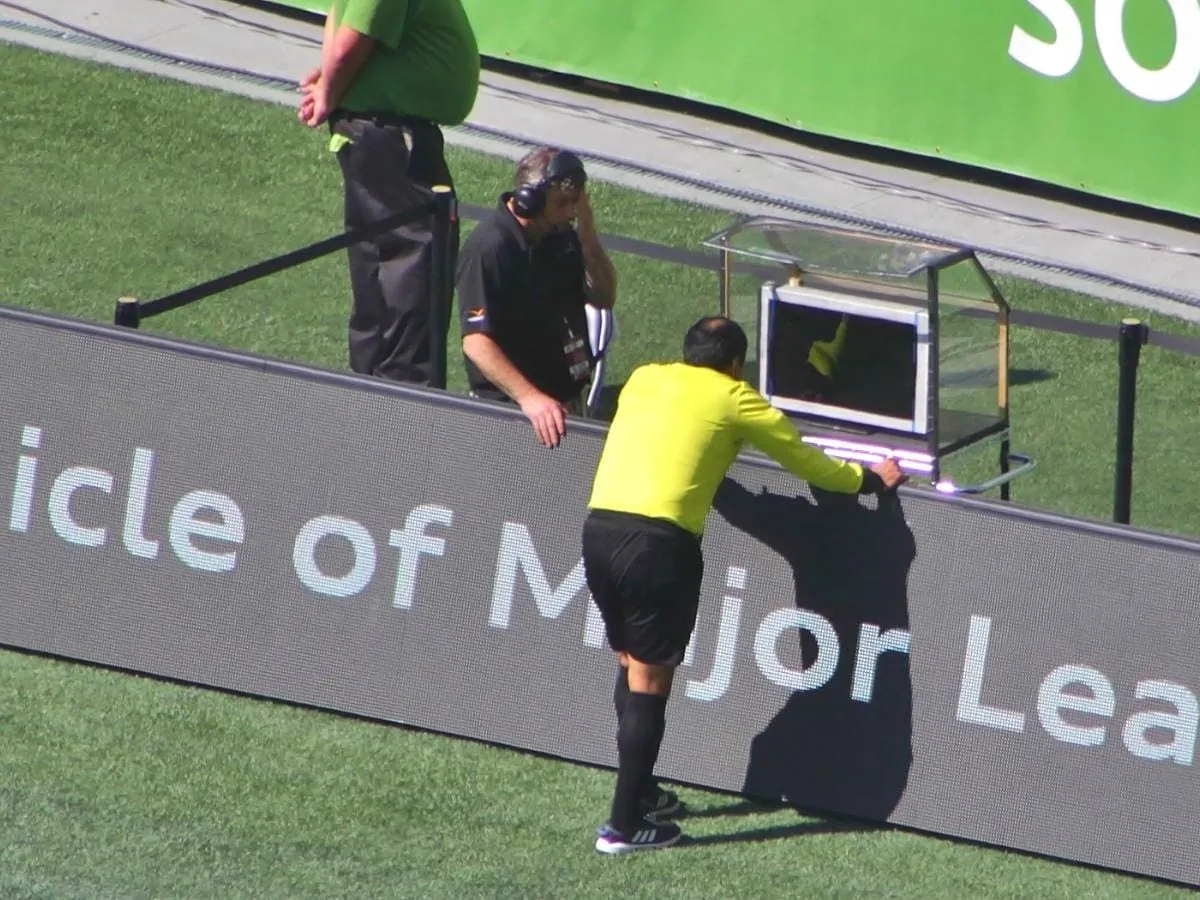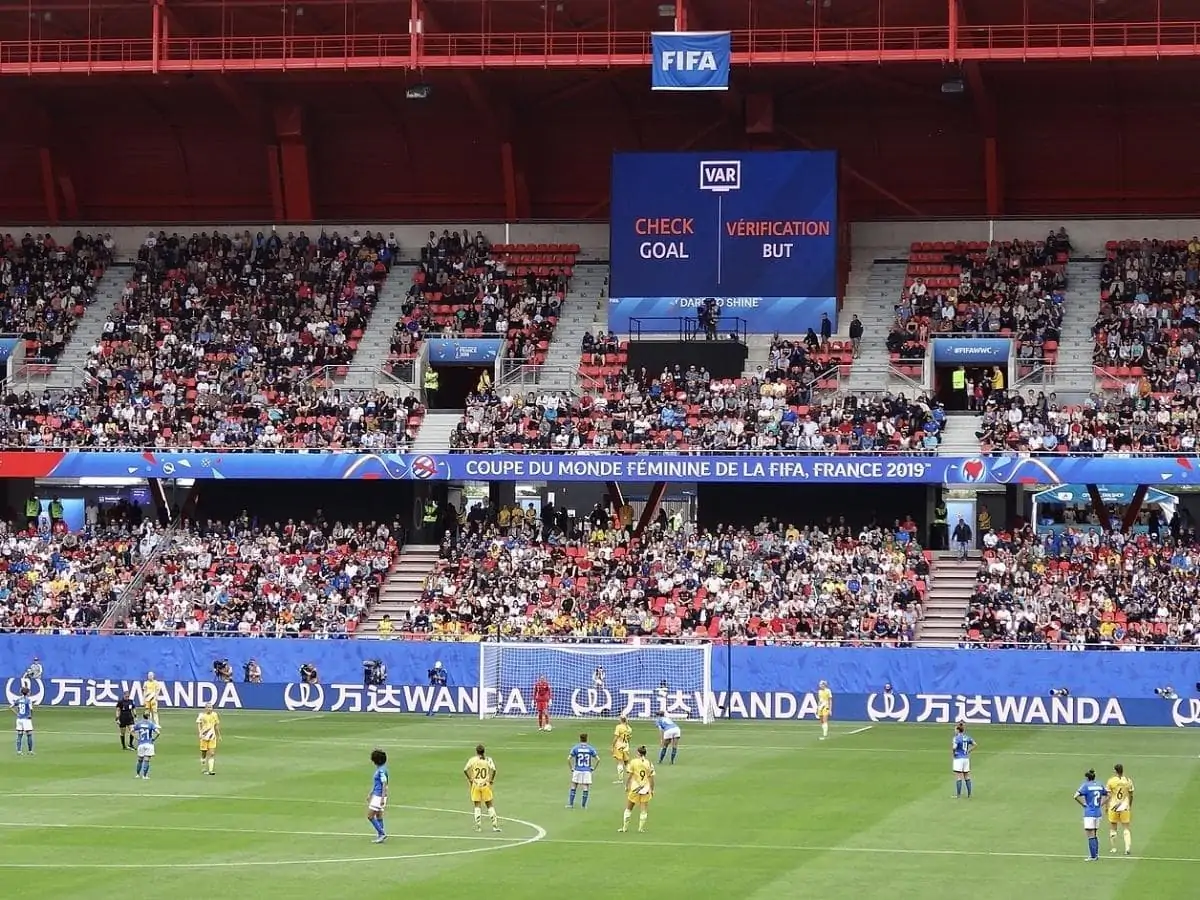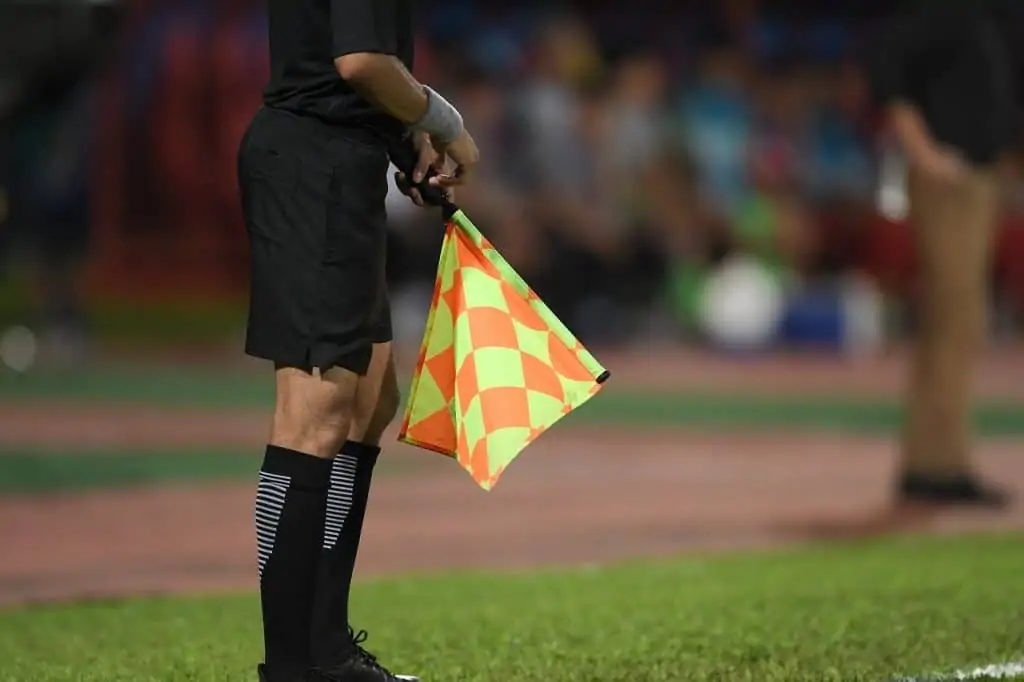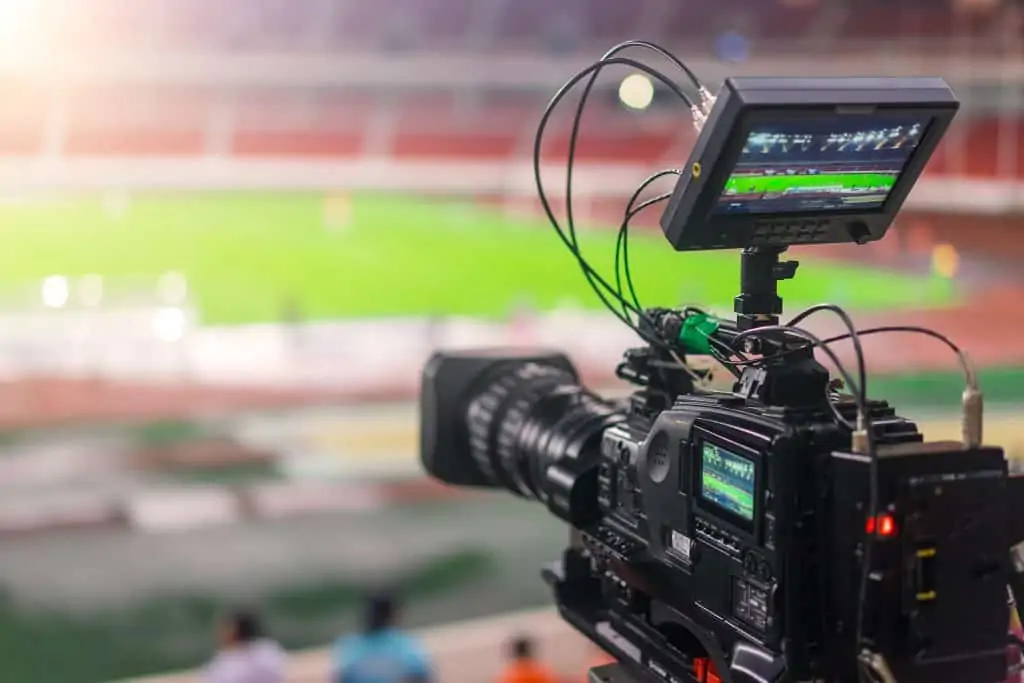Share the post "Is Var Good for Soccer? (Good, Bad and Benefits!)"
A huge impact on the modern game has been the introduction of the ‘Video Assistant Referee’, or VAR as we commonly refer to it. Many games have been won and lost based on a bad decision from a referee.
This new technology aims to reduce errors and make the game fair.
UPDATE: From the 2022 season, fewer decisions will go to VAR, allowing the game to flow, and the lines used to decide offsides will be thicker, giving an attacker the advantage.
“So it’s the toenails, the noses of players that were offside – they won’t be offside now.”
Mike Riley – EPL Referees’ Chief
IFAB (FIFA) states no official line thickness for VAR, so all leagues can decide on a fair thickness to keep the flow but rule out the obvious.

- Is VAR good for soccer?
- Why is VAR a good thing?
- When was the Var first used?
- How Does VAR Work?
- When is VAR Used for Goals?
- Benefits of VAR in soccer
- When Was VAR First Used in The MLS?
- How Has VAR Changed the EPL?
- Number of VAR Errors Improved
- How many decisions has VAR got wrong?
- Is VAR Good for Soccer?
Is VAR good for soccer?
The VAR is a match official who reviews decisions made by the on-field referee, using video footage. The VAR official communicates with the referee using a headset if a ‘clear and obvious error’ or a ‘serious missed incident’ occurs.
The VAR communicates with the referee and can take action regarding the missed incident.
Although cameras have been used, there have been a number of errors since its introduction.
Why is VAR a good thing?
VAR was introduced to eliminate contentious offsides and egregious mistakes by officials. In theory, the offside rule is definitive, and there is no room for debate on whether a player is offside or not (or so we thought).
Therefore the VAR should get the decision right every time, making for a more even playing field.
When was the Var first used?
VAR was first trialed in the 2013/14 season in the Eredivisie (Dutch Soccer League). It was used in various other trial scenarios over the next several seasons.
In March 2018, VAR was first written into the IFAB Laws of the Game.
The first league to use VAR in full was the MLS in 2017. The World Cup first used VAR IN 2018. It was then used in the knockout stages of the Uefa Champions League for the 2018/19 season.
It’s now used in most major soccer competitions worldwide.
How Does VAR Work?
Following the international laws at FIFA and AFC;
- An incident happens, and the referee instructs VAR to look closer. Or VAR instructs the referee that they need to review the situation.
- The video assistant referees watch replays of the action from various angles to ensure the correct decision.
- The VAR panel informs the referee of the correct decision via a headset where they can communicate.
- The referee can agree with the VAR panel, or
- The referee can go to the sidelines to monitor the replay.
When is VAR Used for Goals?
The assistant referees will monitor the game from the sidelines or stand and if there is a foul or cause for the goal to been ruled out; the referee will be notified. There could have been a foul in the build-up of the goal the referee and his/her assistants did not see.
- Offense in the build-up
- Offsides
- Ball out of play
- Goal or no Goal

Benefits of VAR in soccer
Penalty Decisions
If the referee thinks that there was no penalty in play, this could still be overturned by the VAR officials. Play will continue, and if there was anything missed.
If a decision is unclear, in a case where the referee could not see the action from their view, they can consult VAR to ensure the correct decision is made.
- Incorrect award
- Penalty not awarded
- Location of offense
- Offense by attacking team
- Ball out of play
- Offense by kicker or goalkeeper
- Encroachment on a penalty being taken

Red Cards
Red cards given by the referee can be overturned by the VAR panel, as they review the action constantly. The referee can also consult the VAR panel if a decision is unclear.
- Denying an obvious goal-scoring chance
- Serious foul play
- Violent conduct
- Using offensive gestures
Mistaken Identity
Suppose a player is mistakenly given a red or yellow card by the referee when it should have gone to another player. VAR will instruct the referee so that there is no error.
- Only used after the referee has made a decision
When Was VAR First Used in The MLS?
The MLS first introduced VAR into the game in the season of 2014/15 when the system was trialed in several games to test if there was time to stop the game to make the reviews.
The NFL first tested instant replay videos in 1976 and it was another 10 years before it was officially voted in as a part of the game in 1986.
Soccer is behind the times on this action! With the NFL, tennis, cricket, and rugby all using video-assisted replays, there are enough fine examples of how it’s done.
The MLS Leads The Way with VAR
The MLS’s drive to become one of the leading leagues in soccer in the world led them to introduce VAR before any other country. It was in 2017 when VAR was introduced, even before the first use in the World Cup of 2018.

How Has VAR Changed the EPL?
One of these competitions that have adopted VAR is the English Premier League. This is expected to improve the game, but VAR has caused much controversy in the EPL.
Many debatable decisions have been made by VAR (including offsides), leading to question marks around its introduction in the first place. Is VAR being used wrong? Should certain rules be changed for the VAR era of soccer?
A lot of rules in soccer have room for on-field interpretation to allow a real-time referee to officiate as effectively as possible.
There must be no room for such an interpretation when reviewing decisions after the fact. Decisions need to be cut and dry.
Number of VAR Errors Improved
To get an idea of the rates that VAR can improve the game, we can take a look at the NFL. Since 1999 the number of overturned video replays has been 34%.
The accuracy of the decisions in the MLS without VAR was 94.4% correct with VAR improving it to 98.4%.
The number of errors shown in the figures is relatively low, but technology can also play a part in the discipline of the players and conduct. Watch the videos on MLS’ website for several good examples of how VAR is effectively used.
How many decisions has VAR got wrong?
High-profile offside decisions made in the Premier League in the 2019/20 season appear to have millimeters between players.
Many fans and pundits have argued that VAR is perhaps too harsh in such instances.
Sportbible points to a claim that VAR is only accurate to 20cm when detecting offsides due to the distance between video frames capturing a player running at high speed.
The explanation of how VAR is being used for offsides and details on its technology would suggest otherwise. The English Premier League website demonstrates a highly technological and accurate system.
Perhaps these are teething problems, and fans and pundits just need time to get used to the tight margins being penalized by VAR.
Alternatively, one could make the case that the issues lie with the rules themselves.
Should we see changes to the offside rule to suit a VAR ruled game, rather than the on-field human eye? Only time will tell.
Is VAR Good for Soccer?
VAR had a difficult start in the game of soccer. Maybe it was introduced too soon before the players and fans knew the rules.
That alongside the process it took to get a decision and, most importantly, the time needed to wait.
Soccer is a high-speed game, and the fans will not appreciate anything that slows it down. But now, the process has been streamlined – getting the decision reviewed faster and the game going.
Having the correct decision awarded is the ultimate aim, which pleases the fans.
The verdict is still out on whether VAR is good for soccer. There have been many mistakes in its inception, but it’s also righted a few wrongs.
Only time will tell if the stoppages are for the game’s benefit, only if it’s sped up and the right calls are made.
There will always be the odd contentious decision with this game measured on fine lines – that’s for the fans to groan or gloat about.
For more easy-to-understand rules on soccer, see our collection of rules.
Related Questions
Can Players Ask For VAR To Look At A Decision?
If players tell the referee they need to use VAR aggressively; they’re in danger of receiving a yellow card.
How Far Back Can VAR Look?
The videos will only be used in the phase that builds up towards the action where the decision needs to be made.
Does VAR Have The Final Say?
The referee makes the final decision, which will be based on their view and the opinion of VAR.
Share the post "Is Var Good for Soccer? (Good, Bad and Benefits!)"
Joel is a seasoned soccer journalist and analyst with many years of experience in the field. Joel specializes in game analysis, player profiles, transfer news, and has a keen eye for the tactical nuances of the game. He played at various levels in the game and coached teams - he is happy to share his insight with you.



